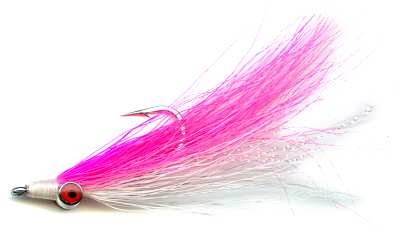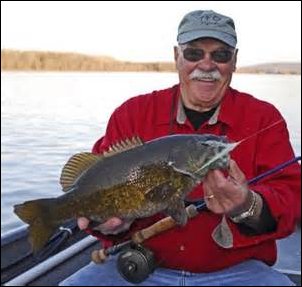Pink & White Clouser's Deepwater Minnow
A Clouser's Minnow is ideal for Bluefish and Striped bass fishing. Striped bass can be found in many costal waters from the St Lawrence River south to Northern Florida on America's Eastern Coast and from Washington to California on the Pacific Coast where they were introduced in the 1879.

INVERTED HOOK PATTERNS. Hook size 2, 4, 6, 8 - $US each
They swim far upstream in rivers to spawn. The stripped bass can be distinguished from the European Bass by the seven to eight dark strips running down its body. Stripers spend the winter semi dormant in river systems like the Hudson and Chesapeake Bay on the Atlantic Coast but when the sea temperature reaches 48 degrees F in the spring they become active and start to feed. The shoals migrate north up the coast and return in September/October. Big fish are caught deep in early winter, but in warmer places like Jamaica Bay they are still caught near the surface. In warm waters they can be fished for all year on the fly. They can feed in the roughest surf. You can see them chasing smaller bait fish along the beach until their backs come out of the water. You will also find them holding in estuaries, deep channels, and off jetties, piers or sand bars.
Bass feed by trapping bait fish against a shoreline or by attacking them from deep below. Small fish are inhaled and larger bait fish are are grabbed head first and crushed. Stripers have a dangerous spiky dorsal fins so handle them by their lower lip. Stripped bass can grow up to 70lb. A bluefish feeding melee can bring up the bigger stripped bass

This is Bob Clouser the designer of the Clouser's Minnow
Stripers can be temperamental compared to the Bluefish who are an aggressive formidable predator that have a full set of sharp teeth. They are found in the same habitat as stripers. The bass normally can be found feeding on Bluefish leftovers of dead and dying fish after a feeding frenzy. If you are lucky you might witness one of these feeding blitz. They corral a shoal of baitfish into a big ball and then when the ball is surrounded they attack.
I was lucky to witness this on my last trip to the States last September. I was fishing for stripers when all of a sudden the captain pointed to gulls swarming around an area of water that was turning white with fish breaking through the surface. 'Bass?' I asked him. 'No those are Bluefish on the feed, change your tippet for wire. Those things have very fast teeth'. I used a floating line with a chartreuse and white 2/0 Lefty's Deceiver attached to the wire tippet. The gulls must have thought Christmas had come early. They were eating as many fleeing bait fish as they could swallow. The noise was very, very loud.
We were told to cast into the center of the swirling mass of activity. I hooked almost immediately. Blue fish are very strong powerful fish. My first was a seven pounder and my second a 12 pounder. The Captain shouted at me to be very careful and use big pliers to extract the hook or end up in hospital with bluefish bite wounds. I must have caught over 12 of about the same size range that day. I had a fantastic days fishing. Later in the bar I found out that many of the locals looked down on bluefish as easy prey. I'm sorry I think they are a wonderful sporting fish.

This is Lefty Kreh designer of the Lefty's Deceiver saltwater flyfishing streamer fly
LEFTY KREH AND BOB CLOUSER
Lefty Kreh, the internationally know author and respected fly fisherman from Maryland, is famous for developing in the late 1950's the modern classic Lefty's Deciever saltwater streamer and his collusion with Bob Clouser on making the Clouser's Minnow . Lefty started his fly fishing addiction in 1947 when fishing guide Joe brooks introduced him to the delights of a fly rod and reel whilst fishing on the Potomic River above Washington DC, USA. When flying ants were falling on the water through exhaustion as they tried to cross the large expanse of water and failed,. Bob would cast to the little rings that appeared on the water surface and catch the rising trout. He did that about eight times. Lefty was amazed. The next day Lefty drove back to Bob's home in Baltimore, Maryland and purchased his first set of fly fishing tackle. Bob gave Lefty his first 9 o'clock to 1 o'clock casting lesson. Lefty carried on practicing and started reading up on his new hobby. Jock Scott's Guide to fly fishing was an early favourite read. It was Bob Brooks who introduced Lefty to saltwater fly fishing in 1964 by getting him a job in Miami working for Orvis. He got to met all the local guides and learn from them. He later started to act as a guide and also demonstrate casting techniques, provide fishing lessons and give talks to various groups around the world.
When asked where his favourite to go fishing was he named Los Rochas in Costa Rica, 90 miles off the North Coast as it has the best quality bonefish that he has experienced in his wide and varied career. Although known for his Lefty's Deceiver fly pattern his favourite saltwater fish is the bonefish. They are a challenge and require skill to fish successfully. Lefty likes the fact that they are a nervous fish that get spooked easily. He uses light tackle and a 7 or 8 weight rod. He has always liked sight fishing on the flats from a boat. When he first fished for bonefish he would cast for about thirty fish before getting a bite now he gets upset if he does not get one in three casts. This improvement in performance is down to patients and learning the correct way to deliver and fish a bonefish fly. Lefty advises to select a bonefish fly that should try and match the colour of the sea bottom in the area to intend to fish. If you are going to fish light coloured flat such as those in the Bahamas or Christmas Islands a white, yellow or light tan fly is the one to choose. If you fish near turtle grass flats then select a dark tan, brown or olive bonefish fly. For Bonefish trips Lefty recommends: the Mini Puff fly for its soft landing ability; the Gotcha as an absolute must for anyone fishing light coloured flats like those in the Bahamas and is one of his must have bonefish flies; the Horror for spooky bonefish; the tan and white Clouser's minnow and the pink and white Clouser's Minnow.

